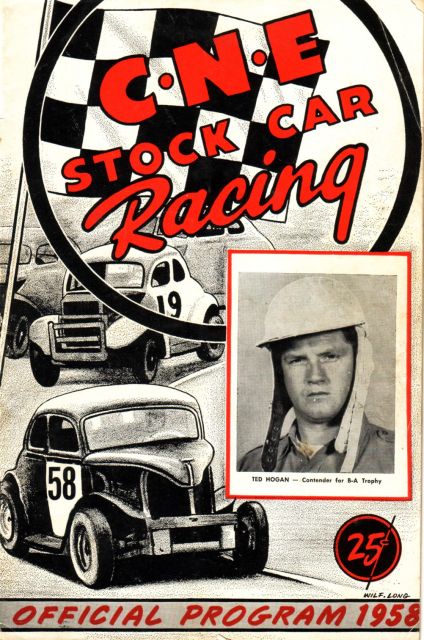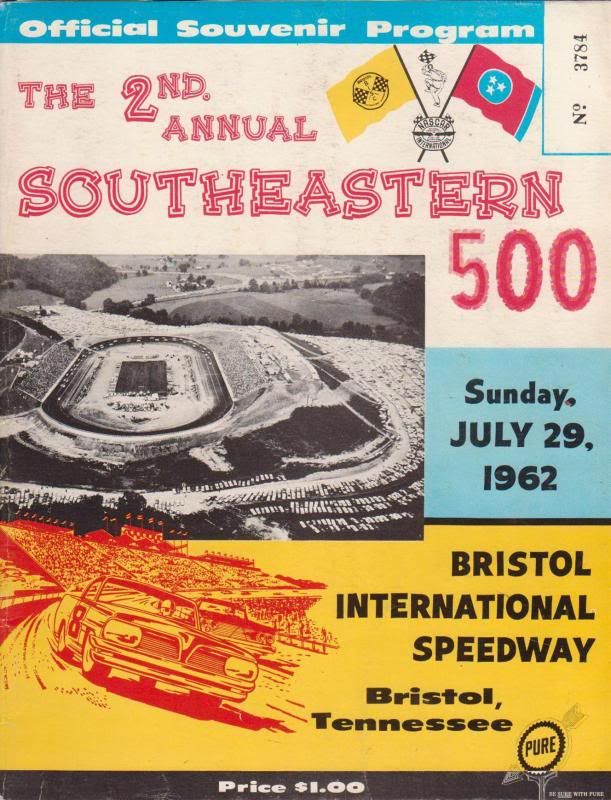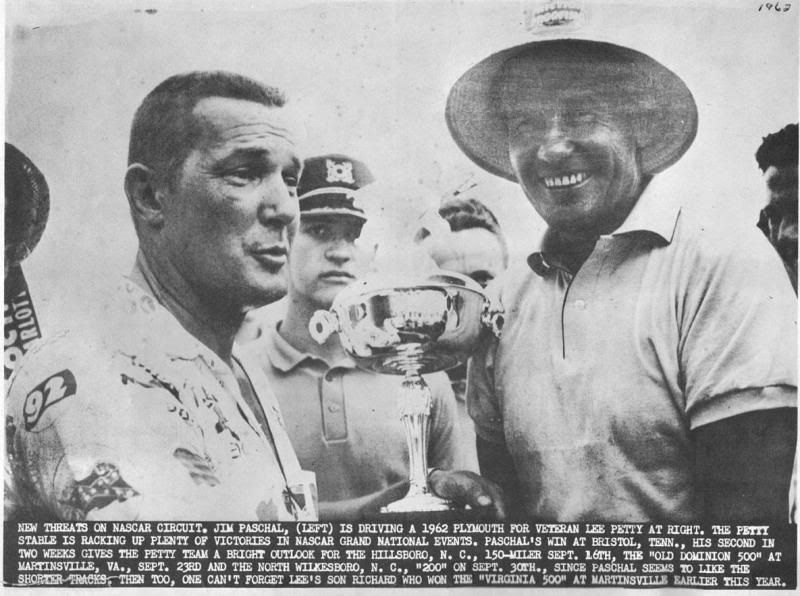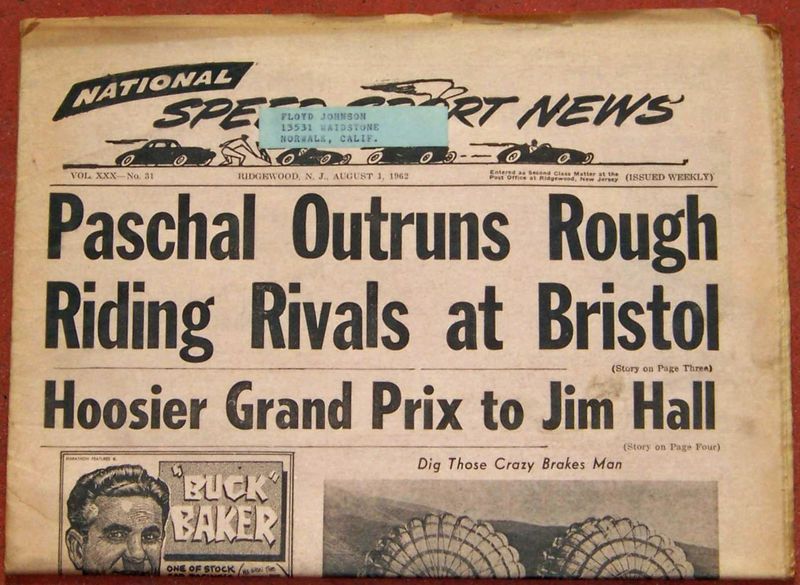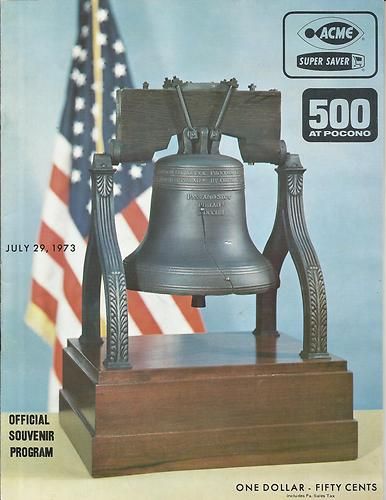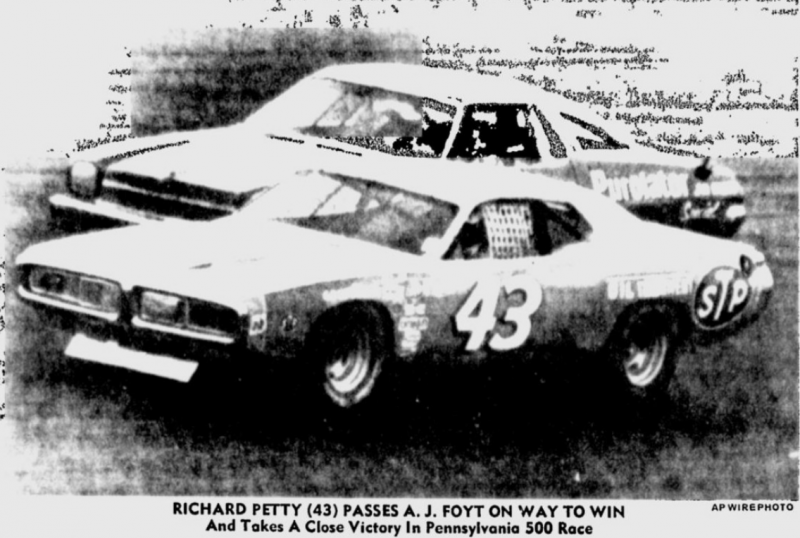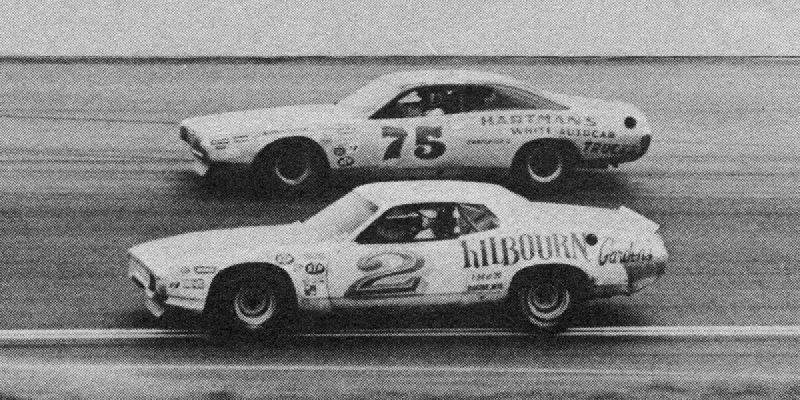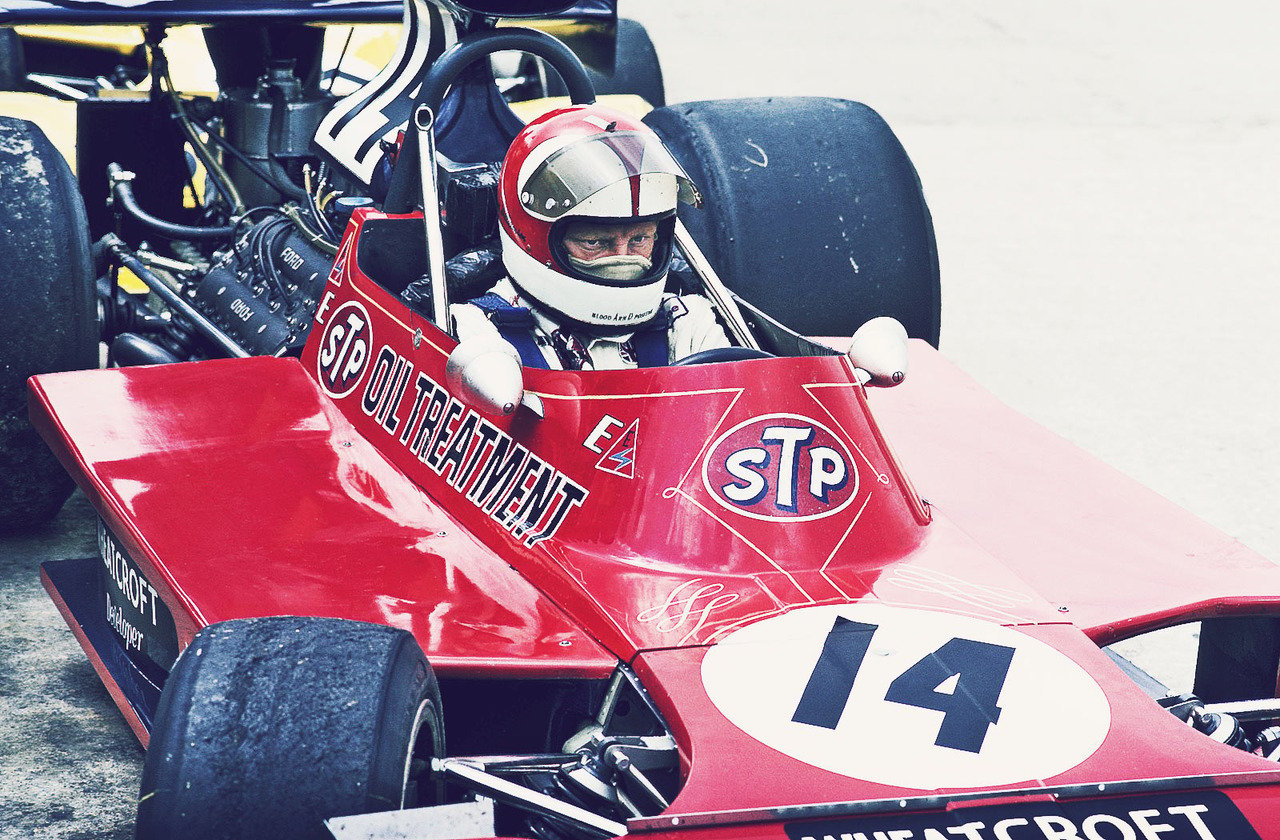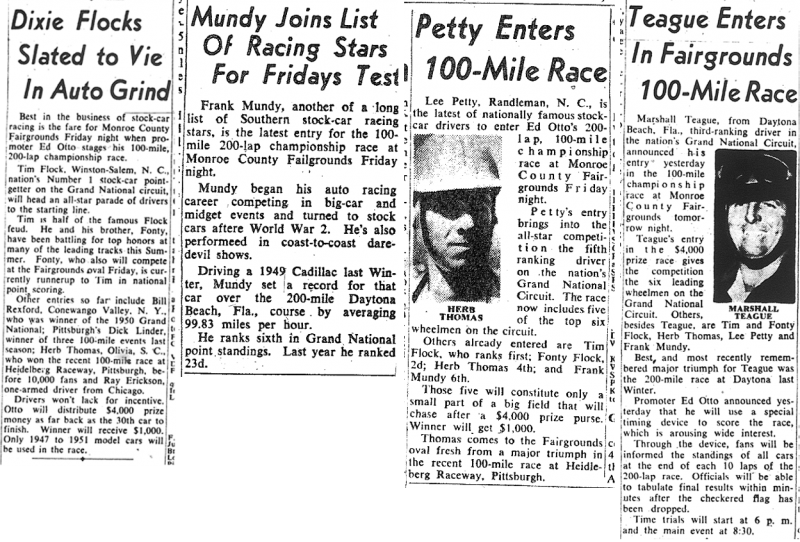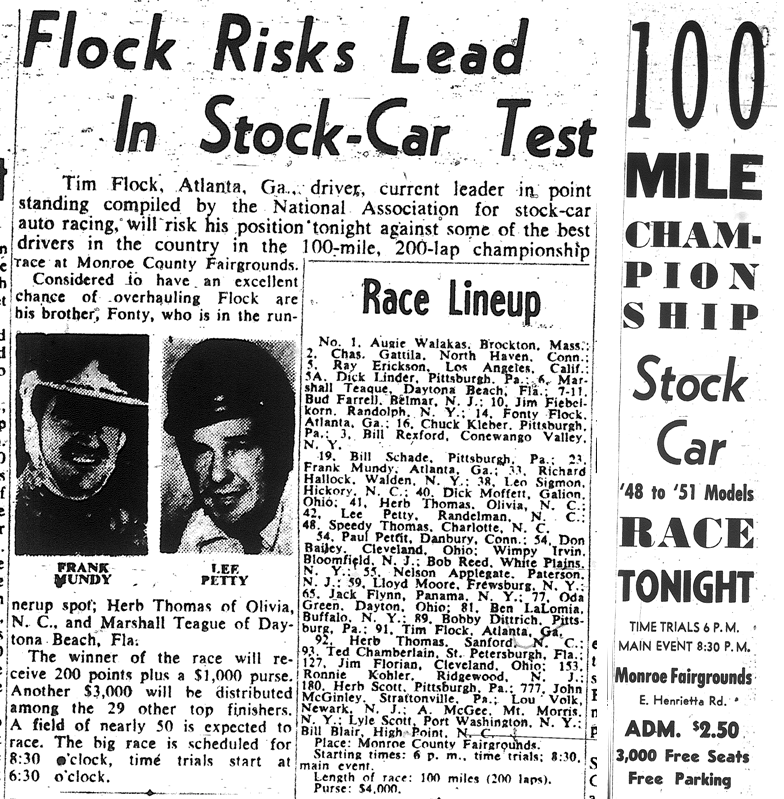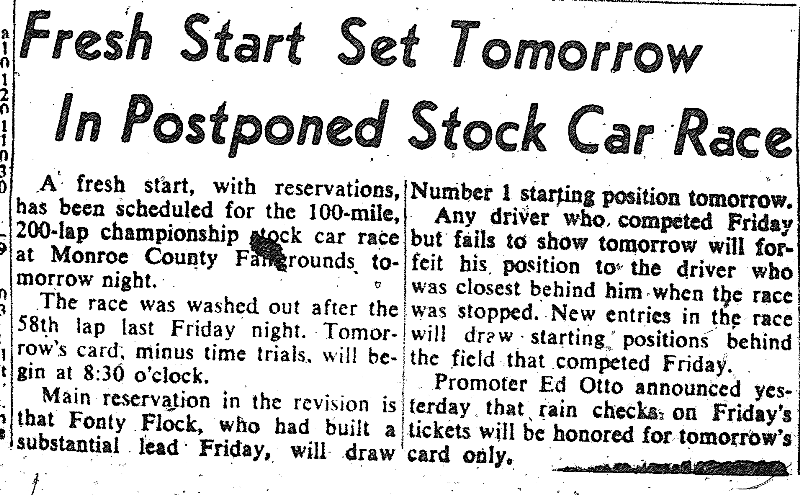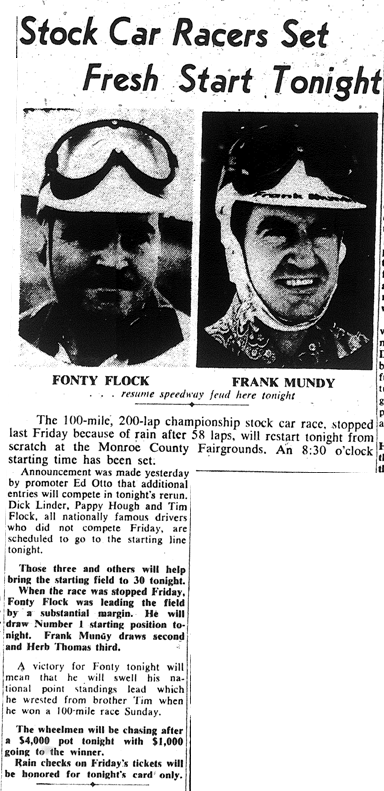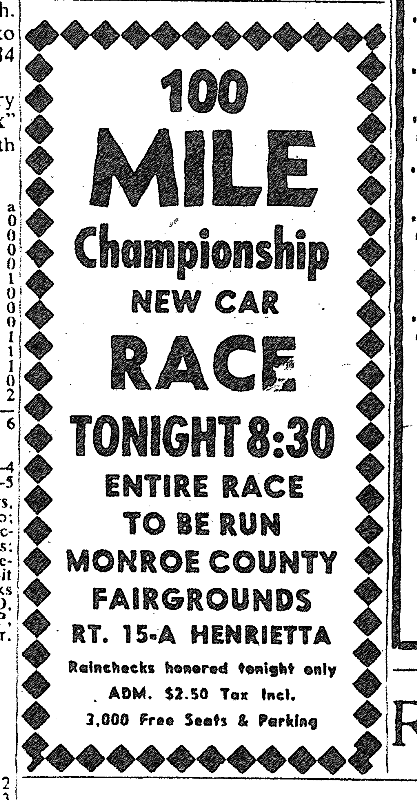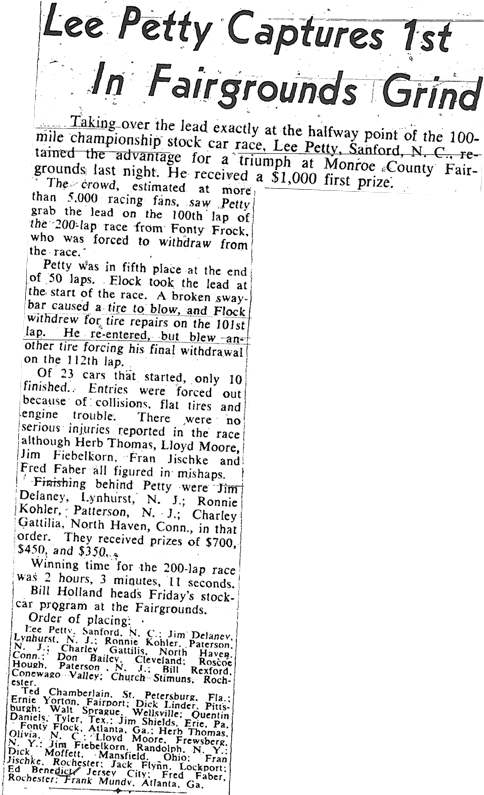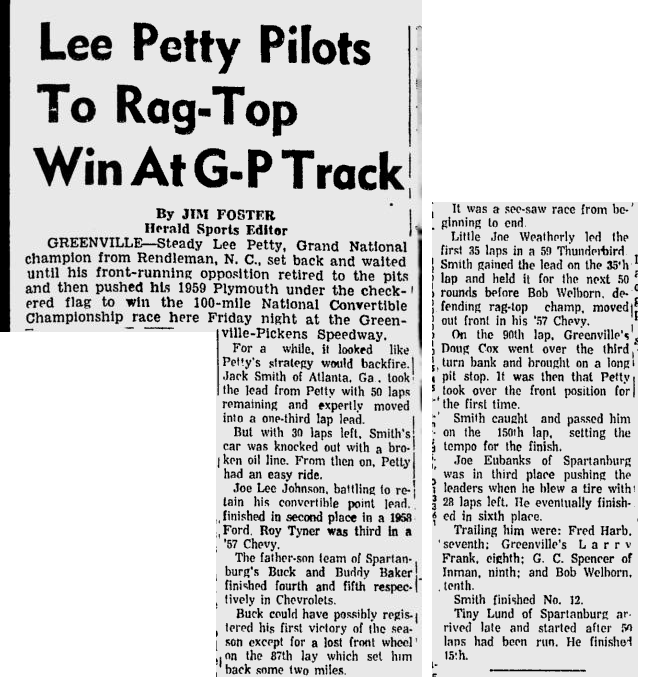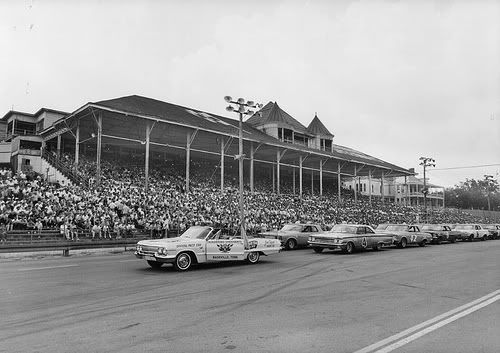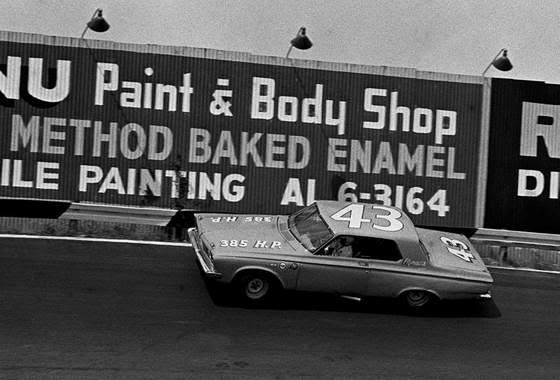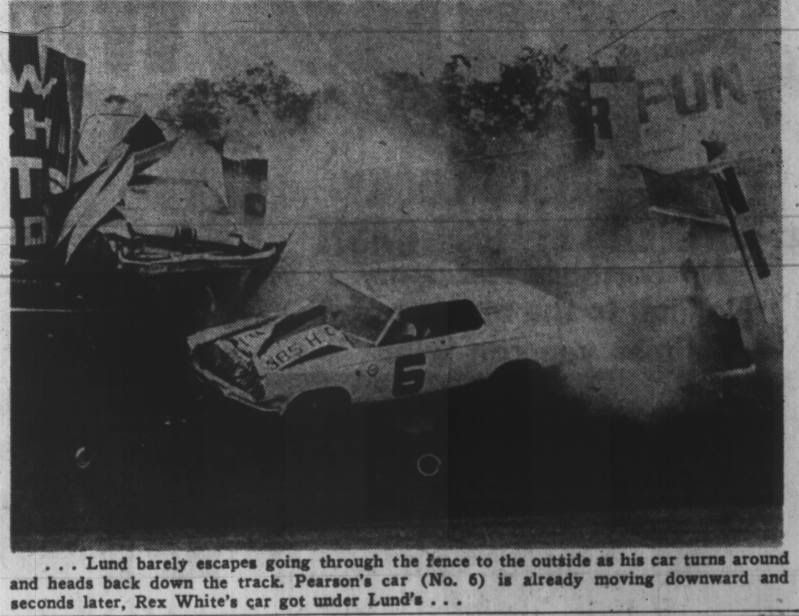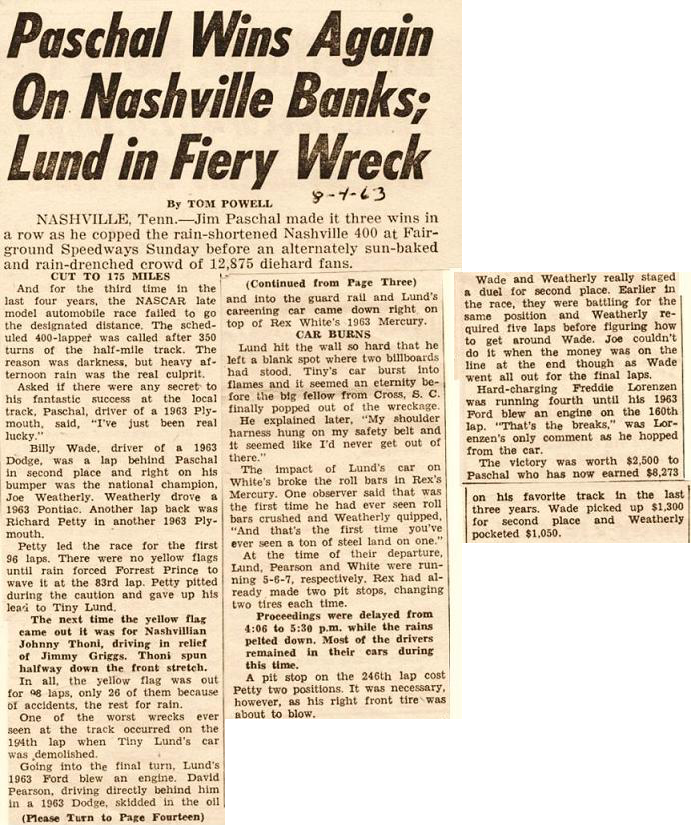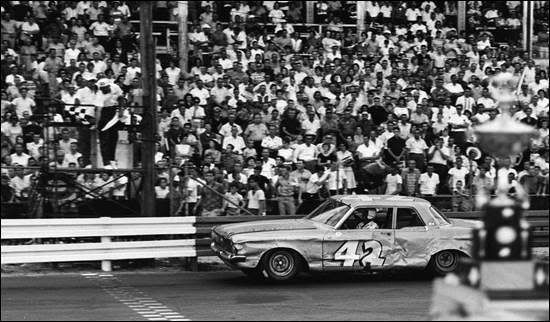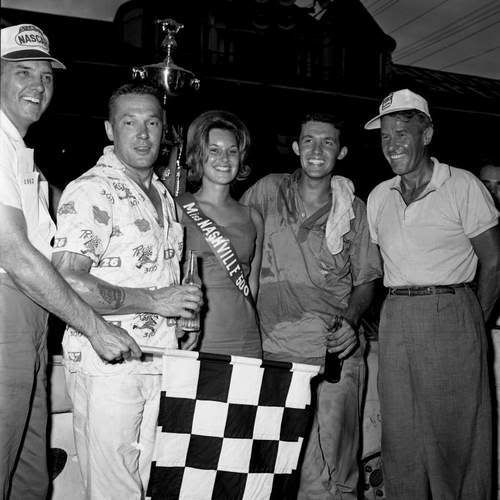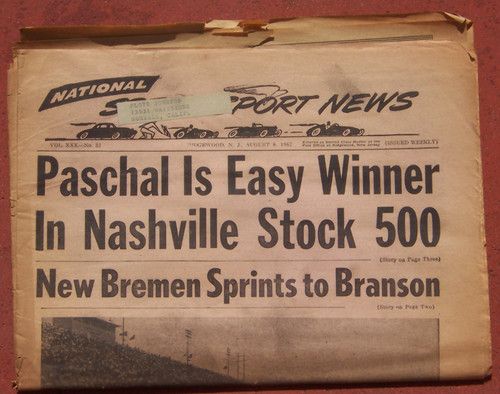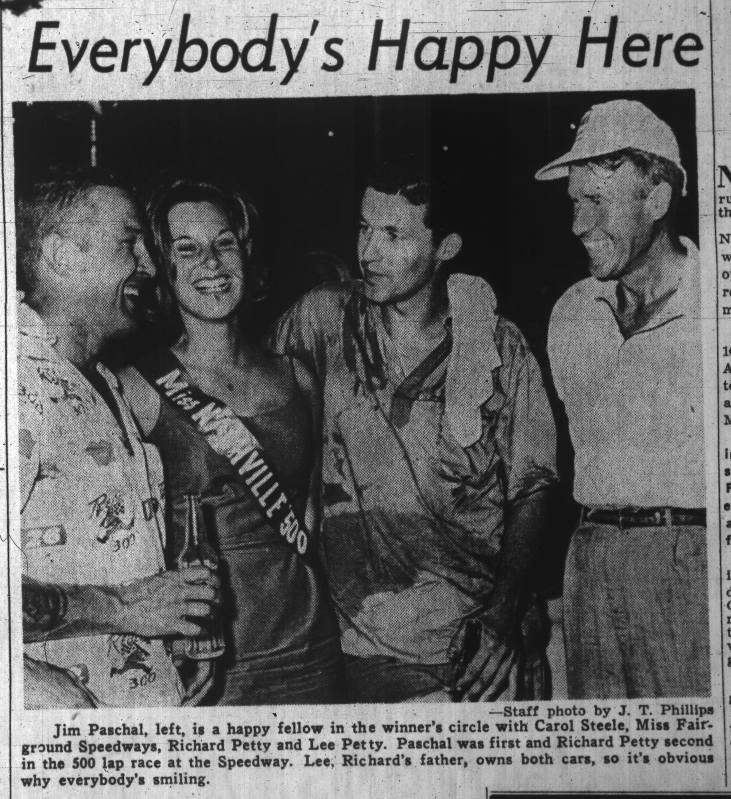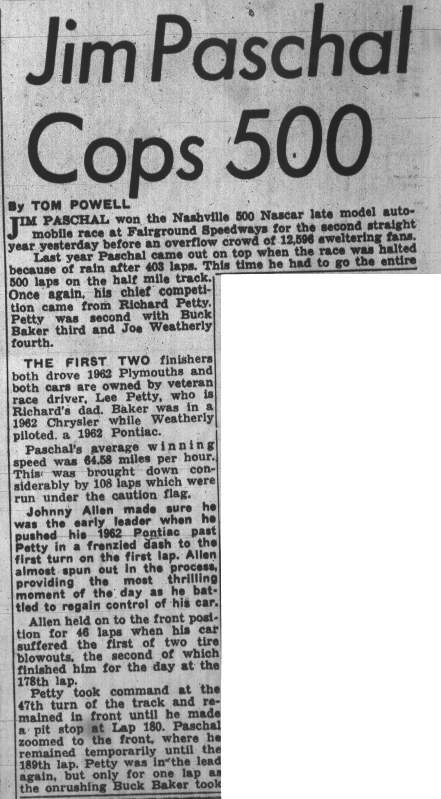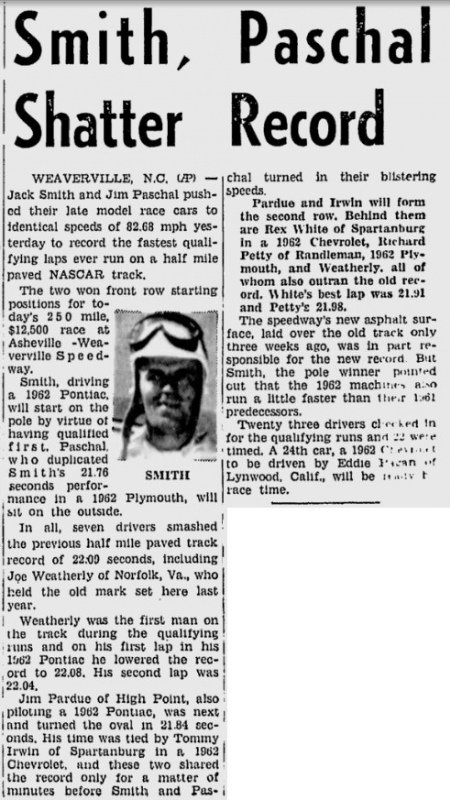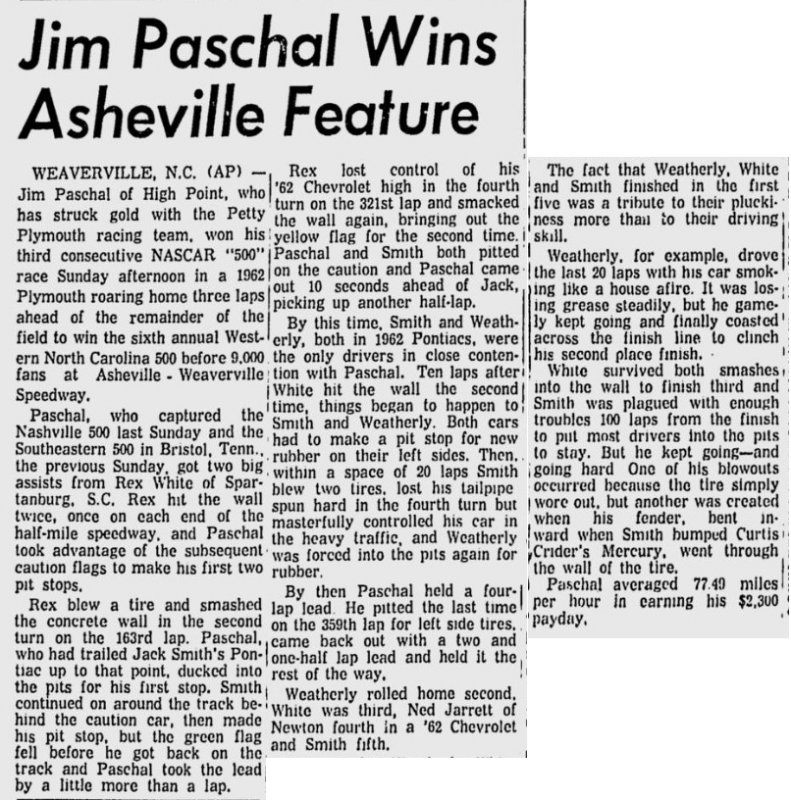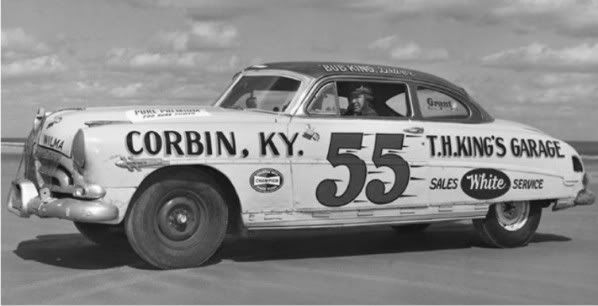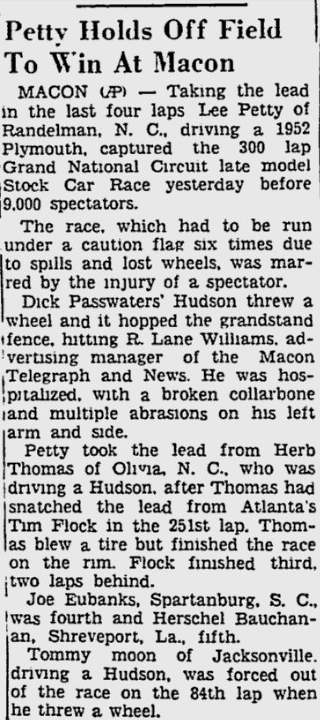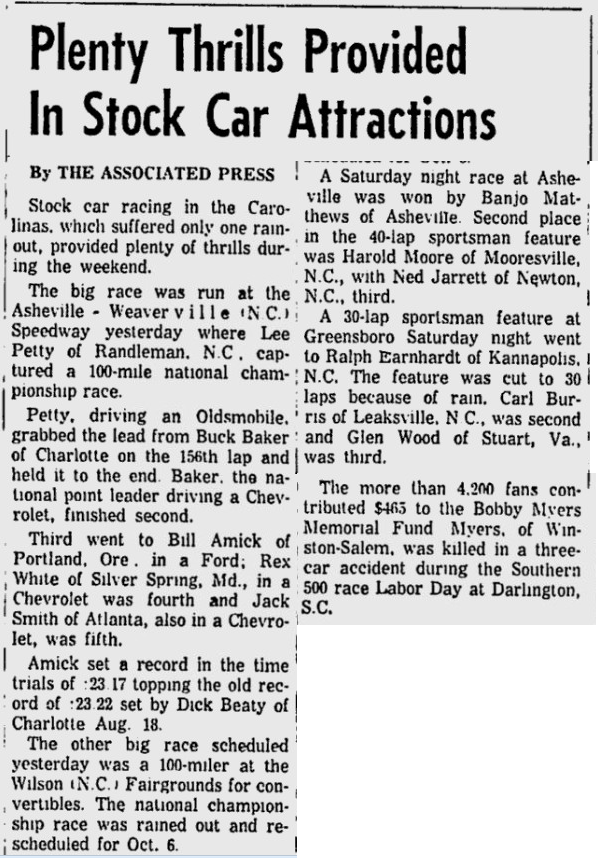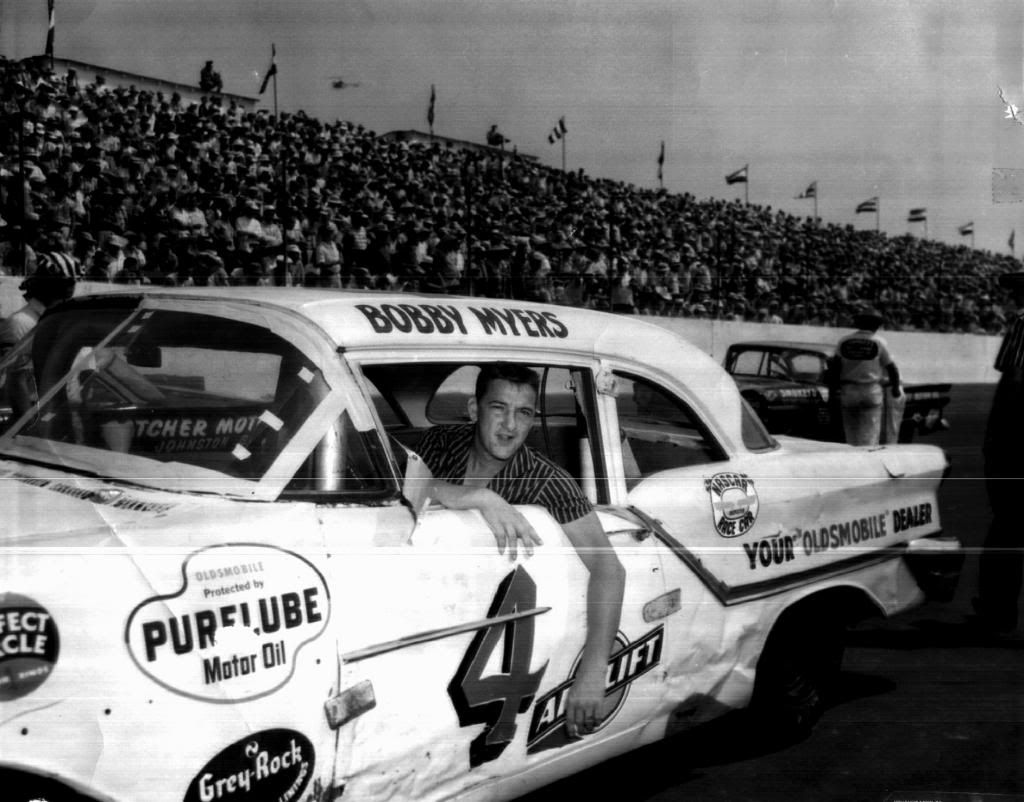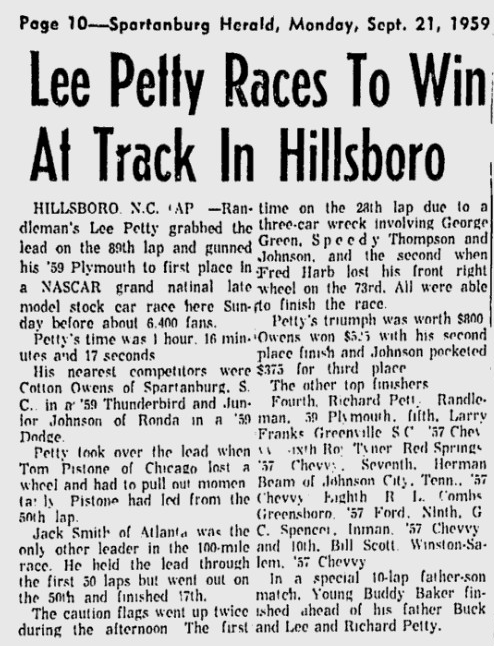July 31, 1951: Driving a #42 Plymouth, Lee Petty wins a 200-lap, 100-mile race on the half-mile dirt track at Monroe County Fairgrounds in Rochester, NY. While the finishing order is documented, its unknown what Petty's margin of victory was over the rest of the field.
The race was originally scheduled for Friday, July 27. From Monday through Thursday of race week, promoter Ed Otto announced various drivers' names who planned to participate. In turn, the news was reported in the
Rochester Democrat Chronicle.
![]() |
| Credit: Rochester Democrat Chronicle - July 23-26. 1951 |
Its unknown if the drivers truly did submit their entry forms in the last few days such that Otto had "news" for each day. The greater likelihood is that Otto did his job as a promoter by hoping to catch a potential ticket buyer's eye with the continual flow of "news" leading up to the race.
Ed Otto had a key role with NASCAR. He helped Bill France expand the fledgling Grand National series by promoting many races in northern states such as New York, New Jersey and Pennsylvania.
This article on speedtv.com notes:
Otto was a true pioneer of auto racing, bringing some of the greatest innovations the sport has ever known. The dapper promoter, whose hallmark greeting was “Hello, Sucker”, was the first to utilize television to broadcast races, the first to incorporate airplanes to transport race cars from one event to another and he encouraged the use of shoulder harnesses in race cars. However, it is possible that his greatest mark was left on NASCAR. As one of the few “outsiders” to be invited into NASCAR’s inner-circle, Otto joined the stock car racing organization’s original owners group as a silent partner with a 20 percent stake in 1949. In 1954 that share grew to 40 percent making him an equal partner with Bill France, Sr. Otto held that role until leaving NASCAR in 1963.
Among his many accomplishments with NASCAR, Otto was the first to take the organization “national”, out of its traditional Southern roots. He was the first to promote a NASCAR race out of the country (July 1, 1952 at Stamford Park, Niagara Falls, Canada) and the first to promote a NASCAR race with foreign cars (Langhorne (PA) Speedway, July 21, 1953). Otto promoted NASCAR’s first road racing event which was held on a temporary course laid out at the Linden (N.J.) Airport (June 13, 1954) and its longest race, a 12 hour endurance event also on the Linden course (August 22, 1954). He promoted “The King” Richard Petty’s first Cup race in 1958 and NASCAR’s first visit to Watkins Glen. The underappreciated legend also sat side-by-side with “Big Bill” France ... when a neck-to-neck finish demanded the two partners determine the first winner of the Daytona 500 in 1959.
Its suggested in this article previewing the race that a "field of nearly 50 is expected to race". Interestingly though, the paper only lists 39 names. Rounded to the nearest 50, I suppose there was an element of truth. For those interested in going, the prices seemed a bargain - $2.50 for a ticket plus free parking.
![]() |
| Credit: Rochester Democrat Chronicle - July 27. 1951 |
Unfortunately, Mother Nature overruled Ed Otto's promotional skills for the evening. After 58 of the 200 laps were completed, the rains began to fall ending the night for the
twenty-three starters. Rather than resume the race at the point it was postponed, Otto announced the full race would be run on July 31st - and without qualifying.
![]() |
| Credit: Rochester Democrat Chronicle - July 28. 1951 |
For the last few decades, NASCAR has resumed rained-out races at the point the original one ended. And more recently, NASCAR has adopted a "next clear day" policy to return to a track as many days in a row as necessary to finish a rained-out or rained-postponed race.
In 1951, however, NASCAR wasn't quite so structured with its policies - or with its schedule and traveling logistics. The next race scheduled after Rochester's July 27th date was two days later at Asheville-Weaverville Speedway in North Carolina. So after driving an average of about 700 miles from the Carolinas to Rochester, the southern teams drove the same distance back home to race in Weaverville. Then following the race at A-W, they trekked back the 700 miles for the make-up date in Rochester - and of course had to drive home again when it was done.
Rather than qualify the cars a second time, a decision was made to have the drivers restart the race in the order in which they were running when the rains fell. Anyone who didn't return forfeited their spot, and the next driver moved up one.
![]() |
| Credit: Rochester Democrat Chronicle - July 30. 1951 |
![]() |
| Credit: Rochester Democrat Chronicle - July 31. 1951 |
![]() |
| Credit: Rochester Democrat Chronicle - July 31. 1951 |
As the leader of the race on July 27th, Fonty Flock started from the pole when it began anew on July 31st. He led the first half of the race before being sidelined with a broken sway bar and a wall slap. Lee led the remaining laps after Flock fell out of the event.
The rest of the starting line-up including Lee's position is unknown. Based on the above article noting how the drivers were running when the red flag was shown, I believe the top five starters for the rescheduled event looked like this:
- Fonty Flock
- Frank Mundy
- Herb Thomas
- Frank Sprague
- Ronnie Kohler
George Siebekorn was running fifth when the race was called. He did not return for the make-up date, and he was never credited with a single Grand National start. Jack White was running sixth in the original race, but he too did not return on the 31st. Bill Rennoe and George Moffett were running 8th and 9th, respectively. But like Siebekorn, neither returned - and neither raced officially in any Grand National race.
Greg Fielden recapped the race in his book,
Forty Years of Stock Car Racing - Vol. 1.
The Randleman NC Plymouth ace took the lead in the 102nd lap when leader Fonty Flock went behind the wall with a broken sway bar.
Jim Delaney crossed the finish line in second place but his Bob Osiecki-prepared Mercury was disqualified for being equipped with a non-stock cam shaft. Charles Gattalia was elevated to runner-up honors. Ronnie Kohler was credited with third, Don Bailey was fourth, and Pappy Hough took fifth. ~ p. 57
The 1951 season was only NASCAR's third for the Grand National series. Many of the drivers who eventually became the legends of the sport had not yet emerged on the scene - or chose not to make the trip to upstate New York. Many drivers such as Speedy Thompson, Gober Sosebee, Tim Flock, Billy and Bobby Myers, Joe Eubanks, Marshall Teague, and Jim Paschal raced at Asheville-Weaverville two days earlier. But only Petty, Fonty Flock, Herb Thomas, Frank Mundy and Lloyd Moore made the long haul from the south back to Rochester.
![]() |
| Credit: Rochester Democrat Chronicle - August 1. 1951 |
Petty earned $1,000 for his win. Second paid $700, and eighth place finisher Ted Chamberlain earned $100. Most of the remaining finishers took home $25. Many of the drivers and their limited crews drove about 3,000 miles over a seven-day period to begin and later finish the 100-mile Rochester race. And the only thing most had to show for their efforts was two Jacksons and a Lincoln. Hopefully Otto paid many of the drivers "show money" for making the haul not just once but twice.
France - with Otto's help - was beginning to grow his new sanctioning body. NASCAR modified ran all over the place, and a few stars were beginning to develop in NASCAR's Grand National series. Apparently the open wheel circuit didn't take too kindly to any of its drivers dabbling in stock cars. (The feelings were mutual as France wanted absolute loyalty from
his drivers.) A couple of days after the race, the Democrat Chronicle previewed another upcoming race at the track. One of the featured drivers expected to race was Bill Holland. In a three-year run from 1947-1949, Holland won the Indy 500 once and finished second twice. But because he dared to also race in a few NASCAR Grand National events, AAA (the forerunner of USAC) kicked him out of its open wheel ranks.
![]() |
| Credit: Rochester Democrat Chronicle - August 2. 1951 |
In the end, however, the two parties apparently reconciled a bit. Holland returned to the Brickyard in 1953 for one final 500, and he raced a few more times in the Indy car series through 1953.
TMC
